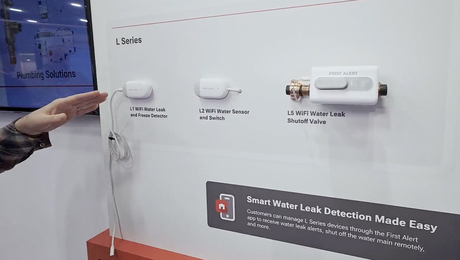Call before you dig
Thanks to John LaTorre for a great article on skid-steer loaders (FHB #149, pp. 68-75). I am an electrical contractor, and I absolutely love the chance to rent one of these versatile machines or another versatile machine, the mini excavator. Mr. LaTorre’s experience shows in his writing and in his harrowing story of tumbling down the hill. With his same respect for safety, I want to share an experience of my own. I was trenching in underground wiring for parking-lot lighting at a new church. Forty-eight hours before digging, I had called our one-call center to check the area for underground utilities. I tell this story with much embarrassment but also with many thanks that it didn’t turn out worse.
At the main entrance of the parking area, the gas line crossed my path. It was well marked. I stuck my spade into the subbase and decided it was too compacted to use the spade. Why not use the mini excavator to loosen up the top 6 in. to 8 in.? Bad idea! The 2-in. gas main that feeds the church was lurking only 6 in. below the surface, and I broke it right away.
I knew to shut off the machine, get clear of the break and call 911. My point is the importance of calling the local one-call center if you plan any digging of any kind.
—Joel Westrum, via e-mail
Vinyl siding: Is there a right way?
Only in Fine Homebuilding would we find an article about the best way to install vinyl siding paired with an article questioning whether we should be using it at all (FHB #149, pp. 82-90).
I was disappointed that the critical article was so focused on the environmental problems of vinyl siding, while slighting design, construction and longevity issues. It would have been more meaningful to compare the environmental problems cited in the article with comparable problems for wood siding and fiber cement—fair is fair.
More important, Fine Homebuilding missed an opportunity to address the bigger questions about the use of vinyl siding: It looks cheap, it feels cheap, it leaks, and when a coat of paint is needed after the integral color fades, the manufacturer’s warranty is often voided.
I do hope the industry will be able to reduce the environmental impacts of producing vinyl because most of us have become quite comfortable with the benefits of plastic pipe and vinyl wallpaper. I’ve even warmed up to vinyl-clad windows. But although vinyl siding may always have a niche in low-end projects, I cannot see how anything like what is sold as vinyl siding today can ever be a suitable cladding for fine home building.
—Bill Spikowski, Fort Myers, FL
A vinyl-siding manufacturer weighs in
I’ve just read the article by Mike Guertin on “Vinyl Siding Done Right”; it’s very good. I would question one photo on p. 87, which shows too much overlap.
When overlapping any vinyl siding, the Vinyl Siding Institute (as do most manufacturers) recommends 1 in. measured from the panel’s end (not between the factory-cut notches). If the siding shown in the photo has 2-in. factory notches, the overlap shown is approximately 31⁄2 in. If secured in that position, those panels would assuredly expand and buckle at some point.
Other than that, I found many of the details Mr. Guertin practices refreshing. I wish all the installations I review showed such care, but if they did, I wouldn’t be there to review them.
Alex Wilson’s article, “Does Vinyl Belong on a Fine Home?” is also good. It seemed to be biased against vinyl’s use, though. Although I agree with greener alternatives, I have a hard time seeing fiber cement as being viable because the silica dust created in cutting is considered toxic and hazardous.
—Rick Lappin, R&D manager/vinyl applications, LP Specialty Products
Windows in vinyl-siding article don’t look properly flashed
The moisture barrier and flashing around the windows in Mike Guertin’s article on vinyl siding (FHB #149, pp. 82-88) caught my eye. What was shown goes against good flashing common sense and against the advice from your past articles.
What’s going on here? Wouldn’t it have been better to make sure the wrap and flashing package was done properly before the photo shoot?
—Eric A. Lutz, via e-mail
Mike Guertin replies: All the windows were meticulously installed using the flashing and weather-barrier details that I described in FHB #129 (“Installing Vinyl-Clad Windows,” pp. 64-69), though it is hard to tell from the photographs.
The rough openings and wall faces were wrapped starting at the sill with 6-in. or 9-in. peel-and-stick flashing membrane material. The flashing pan at the sill wrapped over the weather barrier below it, and the sides lapped over the flashing pan. After the windows were installed, an additional 4-in. layer of peel-and-stick membrane was applied over the side window flanges. None was applied over the bottom flange to allow the pan to discharge any water it collected.
I sliced the weather barrier about 1 in. above the top flange and tucked 5 in. of a 6-in. wide strip of membrane beneath the weather barrier for a good overlap. You may be able to make out only the pieces of flashing membrane that were entirely applied over the face of the weather barrier at the top corners of the windows. These corners are the locations at the ends of the slit I made in the weather barrier to slip the flashing membrane beneath.
A couple of things make the windows appear to be misinstalled. I used aluminum-faced peel-and-stick membrane, which is not found everywhere. It looks a little unusual in the photos. Around most of the windows, I’ve installed J-channel or wide J-casing. You can see the slots around the perimeter of the J, which can easily be confused with the slots in the flanges of the window. As I noted in the article, J-channel shouldn’t be used as flashing. I apply the J over the flashing membrane. The nails used to fasten the J will be sealed by the self-healing modified asphalt of the flashing membrane.
Not all sill plates have to be decay resistant
I was happy to see Lynn Underwood’s article “Top 10 Building-Code Violations” (FHB #149, pp. 58-63). However, I must take issue with his statement that sole (sill) plates must be decay resistant. The IBC 2000, R323.1, note 2, is clear that decay-resistant material is required only when the concrete or masonry is within 8 in. of the grade. Furthermore, by code, R323.1, note 3, sills do not have to be decay resistant on a slab on grade if a vapor barrier is present. This misconception leads to contractors’ placing pressure-treated sills on the top of 10-ft. high masonry walls where there are no decay issues.
—Jeffrey Fertich, P. E., Gettysburg, PA
Plans examiners don’t check everything
Articles such as Lynn Underwood’s “Top 10 Building-Code Violations” (FHB #149, pp. 58-63) are helpful to builders, but this one contains a generalization that even if it is correct for his current jurisdiction, is not universally true and is sufficiently important to require comment.
Underwood writes: “Only after the building department’s plans examiner has verified that the drawings comply with all applicable codes are they issued as approved plans.”
It has not been my experience that any plan reviewers in building-permit offices would either claim to have checked compliance with all applicable codes or accept the liability that such a statement implies—even if they thought they had. Every jurisdiction with which I am familiar makes spot checks of typical problem areas based on experience with common oversights, but makes it abundantly clear that the checking is severely limited in scope and that compliance to code issues remains the responsibility of the builder.
—Karl L. Kirkman, via e-mail
Lynn Underwood replies: My opinion is that professional staff in a building department is hired for a reason: to verify code compliance and search for code deficiencies. Although section R104.8 Liability establishes that employees, acting in good faith, without malice, in the discharge of their duties, are not rendered liable personally, it is still their responsibility to be as thorough and as complete as possible in the course of their duties. Most code-enforcement professionals I know strive to be as thorough as they possibly can be.
Rusty rebar isn’t a problem
In the article “Top 10 Building-Code Violations” (FHB #149, pp. 58-63), Lynn Underwood writes, “The rebar must also be clean when it’s installed: Coatings such as rust or mud decrease the rebar’s ability to bond properly with concrete or grout.” While I agree that mud-coated rebar is not allowed, I must point out that rust on rebar is beneficial.
The code standards that are listed in American Concrete Institute (ACI) publication ACI 318 (Building Code Requirements for Reinforced Concrete), under section 7.4.1, Surface Conditions of Reinforcement, state, “At time concrete is placed, metal reinforcement shall be free from mud, oil, or other nonmetallic coating that decrease the bond.” Section 7.4.2 states, “Metal reinforcement … with rust, mill scale, or a combination of both shall be considered satisfactory …” In the commentary of this code is the explanation for permitting rust on rebar: “R7.4 … Research has shown that a normal amount of rust increases bond. Normal rough handling generally removes rust which is loose enough to injure the bond between the concrete and reinforcement.”
—Michael Shultz, Portland, OR
Lynn Underwood replies: Michael, good call. While ACI 318 does permit some minimum amount of rust remaining after wire brushing or rough handling, there are always problems with agreement between inspector and contractor as to quantifying an acceptable amount. Thanks for the insight. The more discussion about code issues like this, the smarter we all get.
A better way of cutting tile
I’ve enjoyed your magazine very much, but the June/July issue was somewhat disappointing. The cover photo and related article (FHB #148, pp. 58-63) demonstrated a very primitive way of tile cutting. My company has done a great deal of tile work, and I have found that a RotoZip tool (877-768-6947; www.rotozip.com) with a tile bit is faster, more accurate and more professional. Explore this technique. You will find the same result.
—Dave Thomas, via e-mail
Knob-and-tube wiring needs an airspace
After reading “Venting a Downdraft Range” (FHB #149, pp. 96-99), I saw some electrical issues in the big photo on p. 99. The photo shows the electrical wiring system known as “knob and tube.” As shown, this old wiring technique will meet code unless the following applies.
The I. C. light fixture (rated for insulation contact) serving the basement and the fiberglass insulation under the duct lead me to believe that insulation will be reinstalled, a code violation because knob-and-tube relies on an airspace to dissipate the heat generated from operation. Any confinement is a fire hazard, and I would hope the electrician brought the wiring up to code before the floor was closed in.
—Scott J. McCarthy, Hingham, MA
Fine Homebuilding Recommended Products
Fine Homebuilding receives a commission for items purchased through links on this site, including Amazon Associates and other affiliate advertising programs.

Handy Heat Gun

8067 All-Weather Flashing Tape

Affordable IR Camera






















